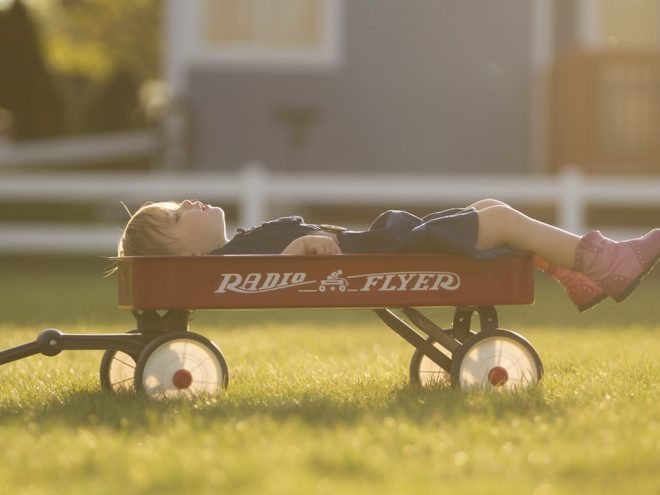They are the window to your child’s world. Vision directly affects your young one’s ability to perceive, learn, sense danger and appreciate beauty. Yet it’s not always easy to discern if your child has trouble seeing, especially if they’re pre-verbal. Below you’ll find some easy-to-follow guidelines which identify the signs of possible vision problems, offer solutions and assure your child’s visual health overall.
Look to Eyesight First When Behavior Is A Concern
Is your child easily distractible? Does he have trouble focusing or seem to “zone out”? Do you feel they show frustration or appear to lose interest quickly? Before you start researching different parenting methods and consider calling Nanny 911, have you kid’s eyes checked. Up to 80% of what children learn requires visual processing. Even though learning begins at birth, far too often marked processing issues are not unveiled until the start of school. Consider how early identification could prevent and insure against the frustration that may be the root of your child’s behavioral challenges.
Know the Warning Signs
Let’s say your child is the perfect angel and you are counting your lucky stars, but you notice:
- frequent eye rubbing
- squinting
- light sensitivity
- excessive tearing
- sitting directly in front of TV
- head tilting
- poor hand-eye coordination
These, too, may be indicators that your child is having trouble with their vision. Carefully observe your child’s repetitive visual habits and note which situations they typically occur in. Such information offers valuable evidence to the extent of their visual health.
Screen Before Your Child Walks
That’s right. Current guidelines recommend children receive their first comprehensive eye examination by six months of age. It is significant to note that while your pediatrician will examine your child’s eyes during their regularly scheduled six-month checkup, a comprehensive exam is more involved. You may wonder if your six month old’s eyes warrant such in-depth assessment. Consider that your child’s eyes, like the rest of them, are currently in a stage of rapid developmental growth. If a visual issue is present, it may continue to deteriorate if unchecked, and require greater corrective action later. Also, at this stage, skills such as depth perception, peripheral vision and eye-hand coordination are paramount as your child becomes mobile. Many parents have conflicting feelings about their child’s first steps, but no parent wants them to be frustrated with vision-associated difficulty.
Wear Shades
Your kid should wear shades, and not just because their future is bright! Your child’s eyes, like their skin, are directly exposed to the harmful rays of the sun. Mindful sunscreen use and sunglass protection should go hand in hand. Make sure your child’s sunglasses filter 99-100% of both UVA and UVB rays. Scratch resistant lenses like those made from polycarbonate are impact resistant as well. Check to make sure the glasses you choose have frames large enough to cover your child’s entire eye area, including the thin, sensitive skin under their eyes. Be a good role model and regularly wear sunglasses yourself. Children love imitating adults! Different styles and colors help make sunglass accessorizing fun, interesting and oh-so fashionable. The cool bands that hold glasses on active adults work very well for children on the move as well.
Limit Electronic Exposure
Today, incidences of myopia in children are at a worldwide are at an all-time high. Previously believed to be the culprit of excessive reading and doing so in poor light, we now know you don’t have to be a bookworm to be at risk. You don’t even have to know how to read. Even if your child does not actively stare at a computer, handheld device or TV, such electronics are typically on in most homes with continuous exposure. Limit screen access and turn devices off during times of non-use. Of course, our lives are necessarily electronics-driven, and there will be countless moments when you are online with your child in tow. Counterintuitive as it sounds, consider dimming your interior lights. People can more easily see computer screens in darker surroundings. Even casual glances can result in eyestrain over time.
Strengthen Through Nutrition
A diet rich in fruits and vegetables supports eye health in addition to general wellness. Getting enough of vitamins A, C, E, zinc, lutein and certain fatty is crucial for healthy eyes. While it’s not always easy to encourage your child to eat vitamin-rich foods, each nutrient recommended above can be found in a variety of foods. Vitamin A is in carrots — yes! — but also spinach, kale, dairy products and egg yolks. Most children enjoy at least one or two different Vitamin C-packed fruit options. Try cooking with vegetable oils to fulfill Vitamin E and fatty acid requirements. You can find lutein in corn, spinach and broccoli. Dietary staples like blueberries, turkey and sweet potatoes also protect against long-term eye diseases such as cataracts, glaucoma and macular degeneration.
Encourage Sound Rest Habits
Eyes need sleep to rest and recover. Keep your child’s sleeping area as dark as possible. Consider blackout blinds for nap time. A nightlight is fine. Some experts believe their pinpoint of light in an otherwise dark room encourages the development of infant depth perception. Remember that resting your child’s eyes does not exclusively require sleep. Set aside moments throughout the day to close your eyes together and take a couple of deep breaths. You’ll both love the restorative breaks! When it comes to protecting your child’s eye health, it all boils down to exercising good visual practice. Screen, feed, rest — and don’t forget the cool shades! Every window to the world deserves complimentary lighting.





